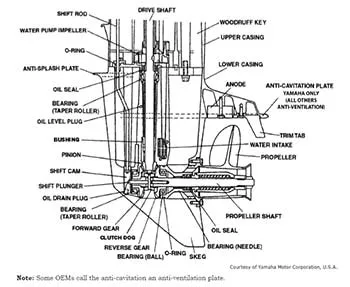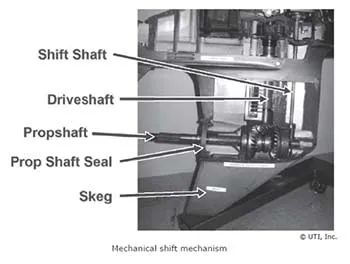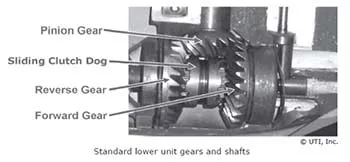How to Become a Marine Diesel Mechanic
Are you a marine enthusiast? You can pursue a career as a marine diesel mechanic. Learn how to become one with our guide!
Whether you’re new to the world of boating or are an experienced enthusiast, you’ll hear terms like outboards, powerheads, tiller and skeg used quite often. But what do these words mean and how do they relate to one another?
Outboard motors are commonly used in the marine industry, and it’s important to understand how their different parts work together. Keep reading to learn about the anatomy of a marine outboard motor and how this knowledge can apply to a career as a marine technician.
Key points
An outboard motor is a propulsion system for boats and is one of the most common motorized methods for propelling watercraft.
Unlike inboard motors, this type of motor is designed to be installed outside the boat on the transom—which leaves more room in the interior of the boat. Benefits of outboard motors include a high horsepower-to-weight ratio, ease of installation and maintenance, and extended maintenance intervals.
An important thing to know about outboard motors is that they come in two different versions: 2- and 4-stroke. In the past, the differences between these two models were more significant. However, thanks to advancements in technology, modern 2- and 4-stroke motors are much more comparable in reliability, weight, speed and fuel economy.
To learn more about the difference between these motors, check out our complete guide to 2- and 4-stroke motors.
A kicker motor, also known as an auxiliary or trolling motor, is a small outboard engine typically mounted on the transom alongside the main motor. Its primary purpose is to provide precise, low-speed maneuverability for activities such as trolling for fish, navigating shallow waters or making fine adjustments in tight docking situations.
Kicker motors are particularly beneficial for anglers who require a quiet, controlled speed to avoid spooking fish. These motors offer an economical and efficient way to extend the range and versatility of a boat, allowing for better fuel efficiency and reduced wear on the primary engine.
An outboard motor operates as a self-contained propulsion system typically mounted on the stern of a boat, providing mobility and maneuverability.
The primary components of an outboard motor include the powerhead, the midsection and the lower unit. The powerhead contains the internal combustion engine, which converts fuel into mechanical energy. This energy is transferred to the midsection, where it drives a vertical driveshaft connected to the lower unit.
The lower unit houses the gearbox and the propeller. When the engine runs, it turns the driveshaft, which in turn rotates the propeller via the gearbox, propelling the boat forward or backward. Additionally, outboard motors often feature a cooling system, typically water-cooled, and a steering mechanism.
Outboard motors consist of three main sections. These include:
The top of the engine contains the outboard powerhead, which is made up of several different components. The midsection refers to the middle part of the engine and the lower unit is located below.
Let’s take a closer look at each of these sections and how they work.
The top section of an outboard motor, or the outboard powerhead, is composed of various components that make up a combustion engine. It houses the engine block, cylinder heads, pistons and valves that make the engine run.
Essentially, the powerhead is made up of the bare bones of the engine, which include the following components:
Together, these components make up the main part of the powerhead.
Another important element to note are cooling passages, which are integrated into the engine block, cylinders and cylinder heads. Essentially, these are channels that allow water that absorbs heat to flow through the powerhead. This makes it so that the engine doesn’t overheat to a point where metals can melt.
To regulate the temperature of the water flowing through the engine, there is a thermostat located in the cooling passages. The thermostat’s job is to ensure the engine is neither too hot nor too cold, both of which can create issues.
The midsection of an outboard motor is a metal casing designed to connect the engine to the lower unit.
This section includes a bracket, which attaches the motor to the transom of the boat. This allows for the engine to turn different directions and for the boat to be steered.
On smaller boats, you will typically find a tilt mechanism that makes it possible to lift the engine out of the water. On larger outboards, and some smaller ones, there is an electric motor that lifts the engine up and down with the simple press of a button.
In the mid-section you’ll also find the driveshaft housing, which serves as the main structural piece of the engine. This includes a water tube that connects to the lower unit and transfers cooling water to the powerhead. This area also houses the driveshaft, which rotates and supplies torque to the lower unit, where the propeller is located.
In a nutshell, the midsection connects the powerhead and lower unit and is what attaches the motor to the boat.
Like the powerhead, the outboard lower unit has a lot of moving parts.

The outboard lower unit sits under the water and contains various components, including:
Shift mechanisms control the rotation of the propeller. The lower unit of an outboard contains mechanical and non-mechanical shift mechanisms. Mechanical shift mechanisms include a vertical cam, a horizontal cam, and a yoke and cradle. The non-mechanical shift mechanisms include an electric shift, a hydroelectric shift or a hydro-mechanical shift mechanism.

The gears in the lower unit transmit rotational force by applying force against the teeth of another gear. In an outboard lower unit, they turn the engine’s output torque 90 degrees to drive the prop-shaft.
The image below shows the three gears located in the lower unit of an outboard: a pinion gear, reverse gear and a forward gear. These gears transmit forces that produce different speeds, torques and directions from the power source.

Wondering how to diagnose problems on an outboard motor? Check out our basic guide to troubleshooting common outboard motor problems.
When it comes to outboard motors, you’ll often hear the terms skeg and tiller.
The skeg is the lowest point on an outboard motor (pictured above). It acts as a precise rudder, which allows your boat to turn safely and effectively. It also protects the propeller from getting caught in debris in the water or other hazards the boat may come in contact with.
The tiller also plays an important role in steering the boat. This is a lever that is attached to a rudder post that can be used by the driver to steer the boat.
As a marine technician, it’s important to know the ins and outs of every product you work on. As outboard motors are a common application on boats, knowing their different components and how they work is critical to being able to do maintenance and repairs.
In the Marine Technician Specialist training program offered at UTI, students learn everything from inboard gas and diesel to outboard 4-stroke and 2-stroke motors. If you dream of a life on the water, this 51-week program can provide you with the knowledge and skills you need to pursue a career as a marine technician.7
UTI’s program is unique in that students have the opportunity to train on products from leading marine manufacturers, including Honda Marine, Mercury Marine, Suzuki Marine, Volvo Penta and Yamaha Marine. Your training will include three-week, manufacturer-specific courses, where you’ll gain hands-on training specific to each brand.
Whether you’ve grown up around the industry or have never worked on a boat before, UTI can provide you with the training you need to pursue a marine mechanic career. Along the way, you’ll have the support of passionate, caring instructors who are dedicated to your successful training.
The Marine Technician Specialist program begins often, and morning, afternoon and some evening classes are available. To learn more, visit our website and request information to get in touch with one of our Admissions Representatives today.
Universal Technical Institute of Illinois, Inc. is approved by the Division of Private Business and Vocational Schools of the Illinois Board of Higher Education.